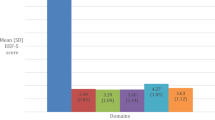Abstract
Our aim was to ascertain if the assessment of erectile dysfunction (ED) should include questions on difficulty in both achieving and maintaining erection. A population-based study of 3143 men in Tampere region in Finland was conducted by mailed questionnaire. The 1983 men who responded questions on erectile function were included in the analysis. Different levels in the severity of ED were used to examine the agreement between the two questions. Consistency was measured by kappa coefficient. Consistency was fairly high (κ=0.71) when the severity of ED was examined in four groups. In those cases where alternative responses were categorized into three groups, consistency was best (κ=0.86) when the alternatives ‘never’ and ‘sometimes’ were combined. Consistency was almost perfect (κ=0.97) when ED dichotomized into two groups and the cutoff was set between the alternatives ‘quite often’ and ‘intercourse does succeed’. The kappa index was 0.86 with the cutoff level between ‘sometimes’ and ‘quite often’ and 0.67 with the cutoff between ‘never’ and ‘sometimes’. When ED was examined in different age groups, the consistency was the highest among the oldest respondents. Responses on both symptoms are needed to distinguish between normal erectile function and minimal ED, and also between minimal and moderate ED, especially in young men. When the aim is to distinguish between complete ED and a milder form, the information from one question is the same as that from two questions.
This is a preview of subscription content, access via your institution
Access options
Subscribe to this journal
Receive 8 print issues and online access
$259.00 per year
only $32.38 per issue
Buy this article
- Purchase on Springer Link
- Instant access to full article PDF
Prices may be subject to local taxes which are calculated during checkout



Similar content being viewed by others
References
NIH Consensus Conference. Impotence. NIH Consensus Development Panel on Impotence. JAMA 1993; 270: 83–90.
Fleiss JL . Statistical Methods for Rates and Proportions 2nd edn. John Wiley: New York, 1981, pp 38–46.
Feldman HA et al. Impotence and its medical and psychosocial correlates: results of the Massachusetts Male Aging Study. J Urol 1994; 151: 54–61.
Koskimäki J, Hakama M, Huhtala H, Tammela TLJ . Effect of erectile dysfunction on frequency of intercourse: a population-based prevalence study in Finland. J Urol 2000; 164: 367–370.
Landis JR, Koch GG . The measurement of observer agreement for categorical data. Biometrics 1977; 33: 159–174.
Conte HR . Development and use of self-report techniques for assessing sexual functioning: a review and critique. Arch Sex Behav 1983; 12: 555–576.
Anderson BL, Broffit B . Is there a reliable and valid self-report measure of sexual function? Arch Sex Behav 1988; 17: 509–525.
Author information
Authors and Affiliations
Corresponding author
Rights and permissions
About this article
Cite this article
Koskimäki, J., Häkkinen, J., Hakama, M. et al. Are questions on both achieving and maintaining an erection needed to define erectile dysfunction?. Int J Impot Res 17, 335–338 (2005). https://doi.org/10.1038/sj.ijir.3901328
Received:
Revised:
Accepted:
Published:
Issue Date:
DOI: https://doi.org/10.1038/sj.ijir.3901328



